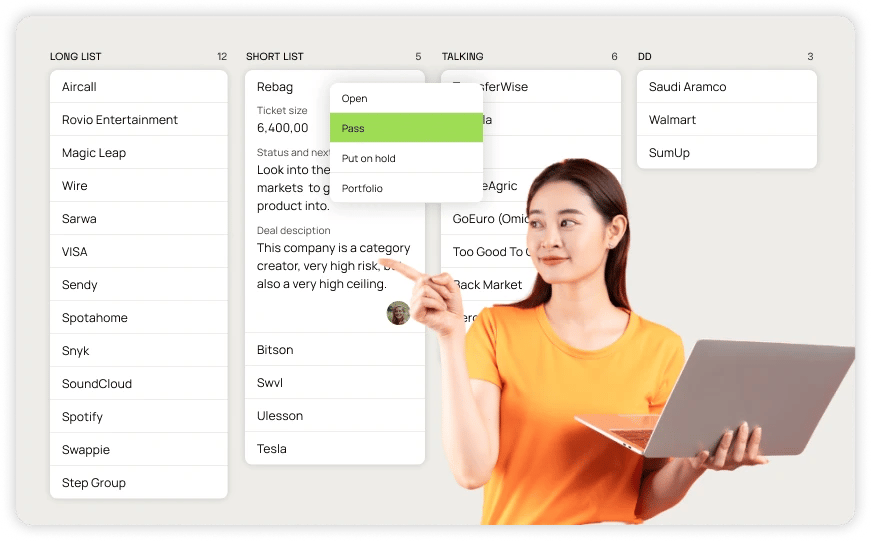Venture capital firms invested a record $329 billion in US companies in 2021. Despite the economic slowdown caused by the Covid-19 pandemic, VCs worldwide continued to invest liberally in emerging sectors like fintech, health tech, and web3.
VCs’ increasing appetite for investment in the face of global economic adversity is indicative of a larger trend witnessed in capital markets over the past decade. As Derek Zanutto, General Partner at Capital G (Alphabet. Inc’s independent growth fund), puts it, “The number of firms at every stage has proliferated, fund sizes have swollen, and asset classes have converged, as VC, private equity and hedge fund investors have increasingly targeted the same deals. In turn, valuations have risen, and funding cycles have condensed.” Amid this growing competition, VCs need to streamline their deal flow process to stay relevant and attract promising, high-quality leads.
Updating your deal flow process isn’t about establishing a competitive advantage over other investors but about collaborating with them and staying in tune with trends in the VC industry. Firms that neglect updating their deal flow management process soon find themselves sidelined by other investors, which cripples their referral pipeline and affects their reputation in the market. An updated deal-sourcing process, on the other hand, can streamline deal flow and help firms make the most of their social capital.
A large number of investors and entrepreneurs now use digital platforms to connect and exchange valuable information, which helps high-potential startups find the right investors that add value to their journey. Social media platforms, personal blogs, online forums, and discussion groups are now the hottest networking spaces in which to connect with other VCs, exchange leads, and lay the foundation for long-lasting business relationships.
Why traditional deal-sourcing methods aren’t as effective now
Traditional deal-sourcing methods were successful when venture capital was one of the only viable fundraising methods for startups. However, over the past decade, startups have embraced alternative means of fundraising through accelerators, angel funds, and crowdfunding campaigns. With the ready availability of a wide variety of startup funding options, VC deal flows are no longer proprietary. This puts the onus on VCs to adapt to the changing investment landscape, prove their value to startups, and find innovative ways to generate quality leads.
As a VC firm adapting to modern deal-sourcing processes, your focus should be on finding the right balance between the quality and quantity of leads being generated. The ideal modern deal-sourcing methods are both innovative and malleable. Aim to design scalable deal-sourcing workflows that:
- Make the best use of all available resources, including social capital
- Help your firm meet its current business objectives
- Can easily be altered or supplemented when your firm decides to scale
How can you switch to better deal-sourcing methods?
Smart use of digital platforms is the key to finding better deal-sourcing solutions. Here are a few tips to help you make the switch.
- Establish an effective follow-up cadence
Modern capital markets are highly competitive. Entrepreneurs with the most promising startups are always being approached by investors (both angel and institutional) who are keen to add their companies to their portfolios. For VCs, the margin for error is slim, and in-time follow-ups are the essential driver of successful deal closings.
Without regular follow-up, you risk losing high-potential leads to other investors willing to offer more time and attention. Timely follow-ups communicate active interest and intent to startups. The way your firm communicates sets a benchmark for the entrepreneurs you fund. Effective communication generates trust and bolsters their conviction that your firm will support their companies in creating value and raising follow-on funding.
The key to establishing an effective follow-up cadence is organizing all inbound communication in an easily accessible format. Collating information about all viable (and active) deal opportunities on one user-friendly platform enables you and your team to closely track and follow up with each startup of interest whenever needed. As the deal progresses, the status of each lead can be updated.
- Make judicious use of data analysis
Different firms have different deal sourcing needs. The kind of deals a VC firm seeks depends on various factors, including current business goals, portfolio strategy, and available resources. For example, if a firm that invests predominantly in fintech companies wants to mitigate market risks, it might decide to diversify its portfolio by investing in other sectors as well.
VC firms usually take such decisions based on solid data analysis that highlights gaps in their current portfolio and suggests possible avenues for course correction. Detailed data analysis helps VCs establish a reliable feedback loop to monitor and streamline its deal sourcing processes for better performance.
Every deal-sourcing method, from network referrals to cold outreach, is prone to problems. Over time, these could turn into pressing issues with the potential to derail deal-sourcing mechanisms and render them ineffective. Regular data analysis helps VCs discover these issues in time. When done right, data analysis also generates actionable insights VCs can use to combat these issues and increase the efficiency of the deal-sourcing pipeline.
- Use digital deal-sourcing channels
VCs have adopted social media platforms and media releases as important communication channels. Both individual investors and investment firms consider these channels to be effective means of discovering leads, exchanging important lead-related information, and gathering key sector insights. This makes it important for VCs to build a formidable digital presence and leverage social networks for effective lead generation. VCs that don’t make a timely switch to generating leads through digital communication channels risk isolation within the investment landscape, while those that do find it easier to make business connections and strengthen their social capital.
Another benefit of digital deal-sourcing lies in the easy collection and collation of all lead-related data. When leads are generated through digital channels, it becomes easier for your deal management system to identify, capture, and organize all relevant deal data.
For instance, if you use web forms for startups to contact you for investment, you can integrate these forms with your deal flow management software so that all lead-related information is automatically captured, filtered, and uploaded onto a central deal-tracking platform. Your team can then review these opportunities and determine whether they deserve a closer look further down the deal flow pipeline. Captured data also allows for automated data analysis and performance report generation, which you can use to keep a close tab on all your deal-sourcing channels.
- Switch to effective deal flow management software
Traditional deal flow management processes can be inefficient, hindering portfolio progress and costing you valuable time and money. Digital deal flow management tools can come to the rescue by automating clerical tasks like data capturing and organization. Well-categorized data can be easily analyzed to produce actionable insights to help you streamline the deal-sourcing process.
Digital CRM-like platforms allow VCs to strengthen the deal-sourcing process by:
- Centralizing all inbound communication
- Generating deal process and portfolio insights
- Reducing clerical work, which speeds up the deal-making process
- Effectively cataloging operational data for future reference
Traditional CRMs can’t cater to the dynamic and highly subjective business needs of VC firms. Zapflow uses the building blocks of a traditional CRM model but tailors it specifically for investment professionals. It allows users to easily capture deal data from several sources, including web forms, emails, and LinkedIn messages, and organize it using custom parameters like lead status and market sector. With Zapflow’s on-demand report generation feature, VCs can glean deal flow insights to streamline and scale the deal flow management process. Contact us for a free demo today.
Get in touch today!



